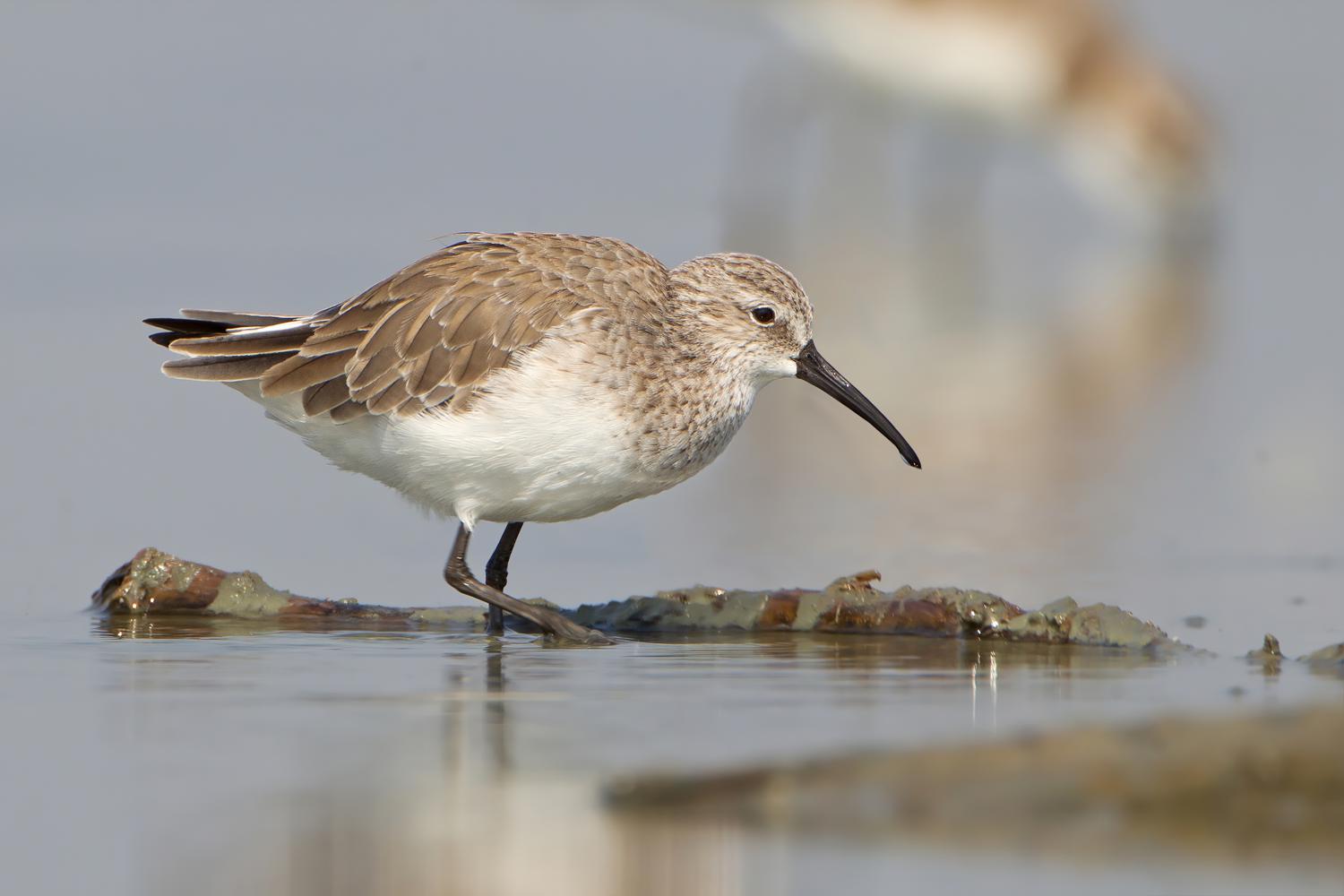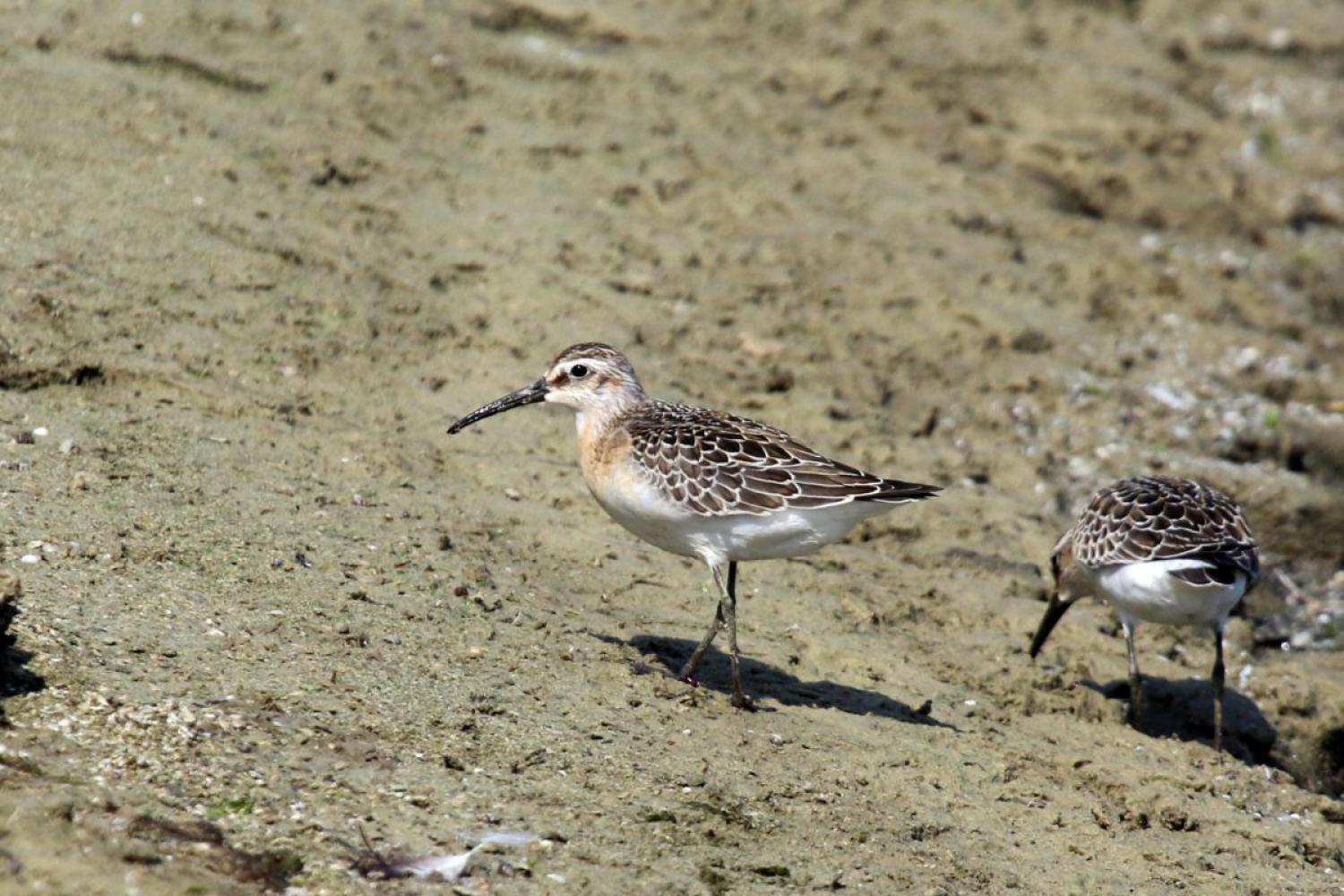Species of Thailand
Curlew sandpiper
Calidris ferruginea
Erik Pontoppidan, 1763
In Thai: นกชายเลนปากโค้ง
The curlew sandpiper (Calidris ferruginea) is a small wader that breeds on the tundra of Arctic Siberia. The genus name is from Ancient Greek kalidris or skalidris, a term used by Aristotle for some grey-coloured waterside birds. The specific ferruginea is from Latin ferrugo, ferruginis, "iron rust" referring to its colour in breeding plumage.
It is strongly migratory, wintering mainly in Africa, but also in south and southeast Asia and in Australia and New Zealand. It is a vagrant to North America.
Description
These birds are small waders, similar to dunlins, but differ in having a longer down-curved beak, longer neck and legs and a white rump. They have a length of 18 – 23 cm and wingspan of 38 – 41 cm. The breeding adult has patterned dark grey upperparts and brick-red underparts. In winter, this bird is pale grey above and white below, and shows an obvious white supercilium. Juveniles have a grey and brown back, a white belly and a peach-coloured breast.
Behaviour
The male curlew sandpiper performs an aerial display during courtship. The clutch of 3–4 eggs are laid in ground scrape in the tundra and taiga, mostly in Siberia.
It is extremely difficult to measure breeding success or population trends in their breeding grounds because nests are scattered over a vast region and their positions influenced by localised weather.
Of all shorebird species, the curlew sandpiper has the smallest breeding range in relation to its non-breeding range. After breeding these birds migrate south to Africa, Australasia or India. South Africa is at the southern limit of the migration path from Siberia, 15000 km or 130° of latitude away.
This wader is highly gregarious, and will form flocks with other calidrid waders, particularly dunlin. Despite its easterly breeding range, this species is regular on passage in western Europe, presumably because of the southwesterly migration route.
It forages in soft mud on marshes and the coast, mainly picking up food by sight. It mostly eats insects and other small invertebrates.
The numbers of this species (and of little stint) depend on the population of lemmings. In poor lemming years, predatory species such as skuas and snowy owls will take Arctic-breeding waders instead.
Counts of the birds in South Africa, specifically at Langebaan Lagoon where they are most numerous, indicate a 40% decline in numbers between 1975 and 2009. A similar trend has been noted in Australia and may be linked to effects of global warming at the breeding grounds.
This species occasionally hybridizes with the sharp-tailed sandpiper and the pectoral sandpiper, producing the presumed "species" called "Cooper's sandpiper" ("Calidris" × cooperi) and "Cox's sandpiper" ("Calidris" × paramelanotos), respectively.
Taxonomy
This is a fairly unusual species, and has been proposed as type species of the genus Erolia but the DNA sequence data is currently insufficient to resolve its relationships. This matter is of taxonomic relevance since, as the curlew sandpiper is the type species, a close relationship with the small "stint" sandpipers would preclude the use of Erolia for the present species.
The curlew sandpiper is one of the species to which the Agreement on the Conservation of African-Eurasian Migratory Waterbirds (AEWA) applies.
This article uses material from Wikipedia released under the Creative Commons Attribution-Share-Alike Licence 3.0. Eventual photos shown in this page may or may not be from Wikipedia, please see the license details for photos in photo by-lines.
Category / Seasonal Status
Wiki listed status (concerning Thai population): Winter visitor
BCST Category: Recorded in an apparently wild state within the last 50 years
BCST Seasonal status: Non-breeding visitor
Scientific classification
- Kingdom
- Animalia
- Phylum
- Chordata
- Class
- Aves
- Order
- Charadriiformes
- Family
- Scolopacidae
- Genus
- Calidris
- Species
- Calidris ferruginea
Common names
- English: Curlew sandpiper
- French: Bécasseau cocorli
- Thai: นกชายเลนปากโค้ง
Synonyms
- Erolia ferruginea, Louis Jean Pierre Vieillot (1816)
Conservation status

Least Concern (IUCN3.1)

Near Threatened (BirdLife)

Near Threatened (ONEP)

Near Threatened (BCST)
Photos
Please help us review the bird photos if wrong ones are used. We can be reached via our contact us page.
Range Map

- Amphawa District, Samut Songkhram
- Ao Phang-Nga National Park
- Ban Laem District, Phetchaburi
- Bang Pakong District, Chachoengsao
- Bang Pu Recreation Centre
- Borabue District, Maha Sarakham
- Bueng Boraped Non-Hunting Area
- Chanthaburi Coast
- Chonburi Coast
- Chumphon Coast
- Khao Sam Roi Yot National Park
- Khao Yoi District, Phetchaburi
- Klaeng District, Rayong
- Kumphawapi District, Udon Thani
- Laem Pak Bia
- Mueang Chonburi District, Chonburi
- Mueang Krabi District, Krabi
- Mueang Pattani District, Pattani
- Mueang Phetchaburi District, Phetchaburi
- Mueang Phuket District, Phuket
- Mueang Ratchaburi District, Ratchaburi
- Mueang Samut Sakhon District, Samut Sakhon
- Mueang Samut Songkhram District, Samut Songkhram
- Mueang Surin District, Surin
- Nakhon Si Thammarat Coast
- Narathiwat Coast
- Pak Thale
- Pattani Coast
- Phetchaburi Coast
- Prachuap Khiri Khan Coast
- Rayong Coast
- Satun Coast
- Songkhla Coast
- Surat Thani Coast
- Takua Pa District, Phang Nga
- Taphan Hin District, Phichit
- Thanyaburi District, Pathum Thani
- Trang Coast
- Trat Coast


